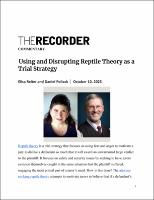Please use this identifier to cite or link to this item:
https://hdl.handle.net/20.500.12202/9292| Title: | Using and disrupting reptile theory as a trial strategy |
| Authors: | Pollack, Daniel Reiter, Elisa 0000-0001-7323-6928 |
| Keywords: | Reptile Theory polyvagal theory ventral vagal dorsal vagal Reptilian complex Paleomammalian complex Neomammalian complex negativity bias the Golden Rule argument juror neutrality |
| Issue Date: | 10-Oct-2023 |
| Publisher: | ALM |
| Citation: | Reiter, E., & Pollack, D. (2023, October 10). Using and disrupting reptile theory as a trial strategy. The Recorder. https://www.law.com/therecorder/2023/10/05/judge-jumps-to-neighboring-court-after-six-weeks-on-the-bench/?slreturn=20230910160018 . |
| Series/Report no.: | The Recorder;October 10, 2023 |
| Abstract: | Reptile theory is a trial strategy that focuses on using fear and anger to motivate a jury to dislike a defendant so much that it will award an unwarranted large verdict to the plaintiff. It focuses on safety and security issues by seeking to have jurors envision themselves caught in the same situation that the plaintiff suffered, engaging the most primal part of a juror’s mind. How is this done? The attorney evoking reptile theory attempts to motivate jurors to believe that if a defendant’s actions are allowed to continue, then the community at large – perhaps even including the jury itself – will risk facing danger. Such attorneys are steering the jury’s mind to a fight or flight response. (from Introduction) |
| Description: | Commentary |
| URI: | https://www.researchgate.net/publication/374583908_Using_and_disrupting_reptile_theory_as_a_trial_strategy https://hdl.handle.net/20.500.12202/9292 |
| Appears in Collections: | Wurzweiler School of Social Work: Faculty publications |
Files in This Item:
| File | Description | Size | Format | |
|---|---|---|---|---|
| Reiter Pollack 10Oct2023 art The Recorder Using and Disrupting Reptile Theory as a Trial Strategy.pdf | 281.39 kB | Adobe PDF |  View/Open |
This item is licensed under a Creative Commons License

